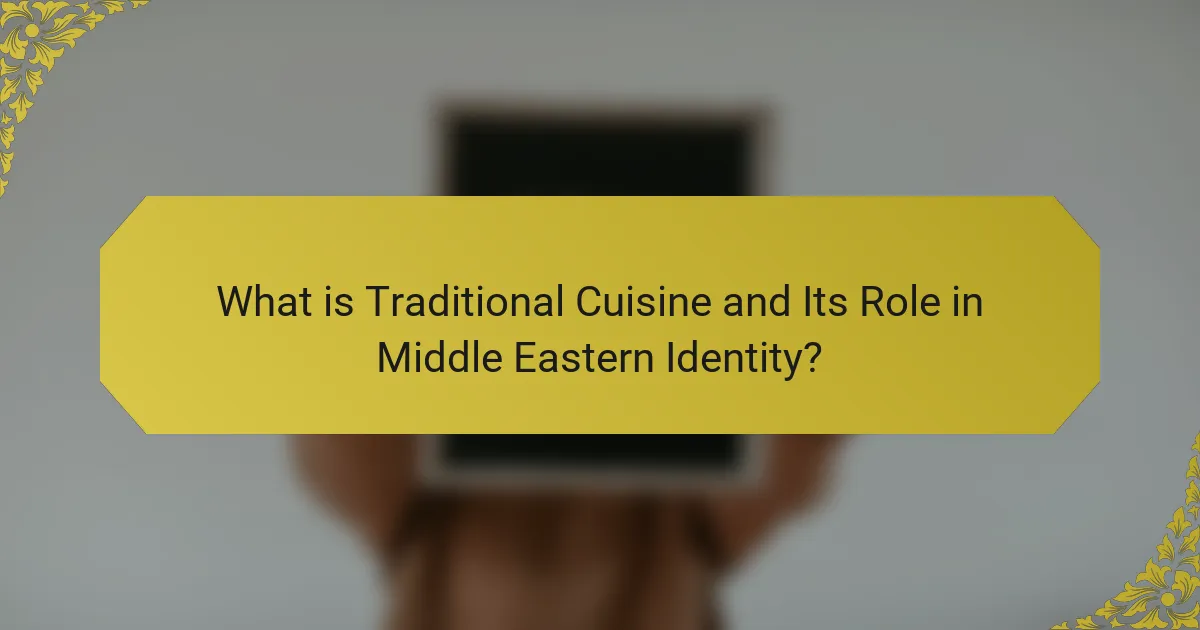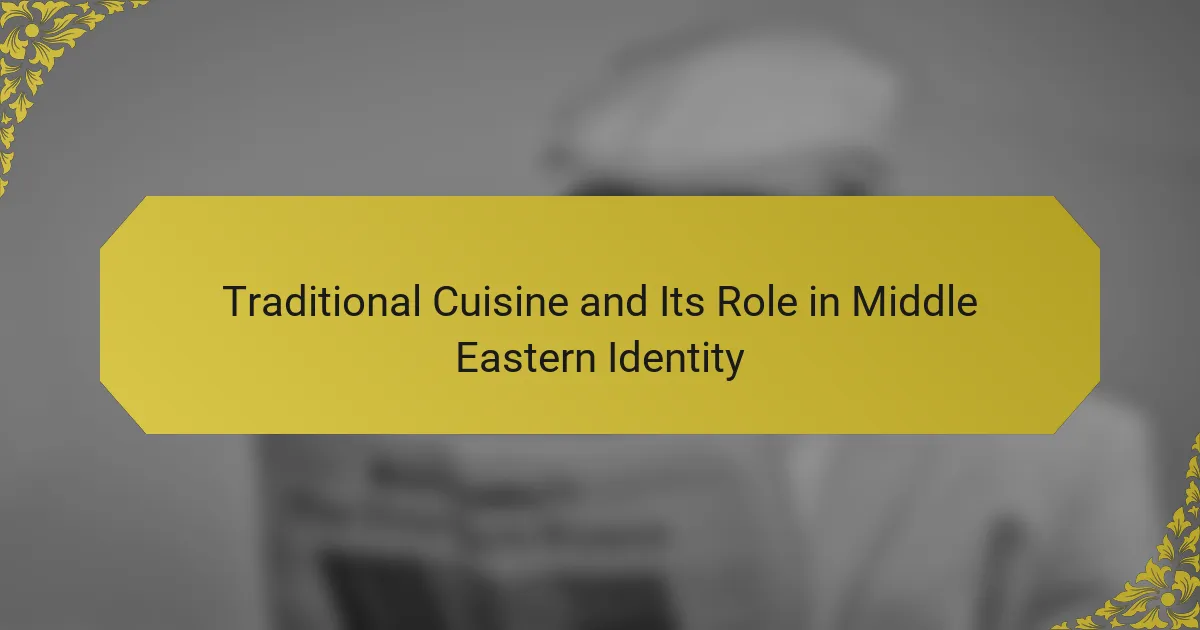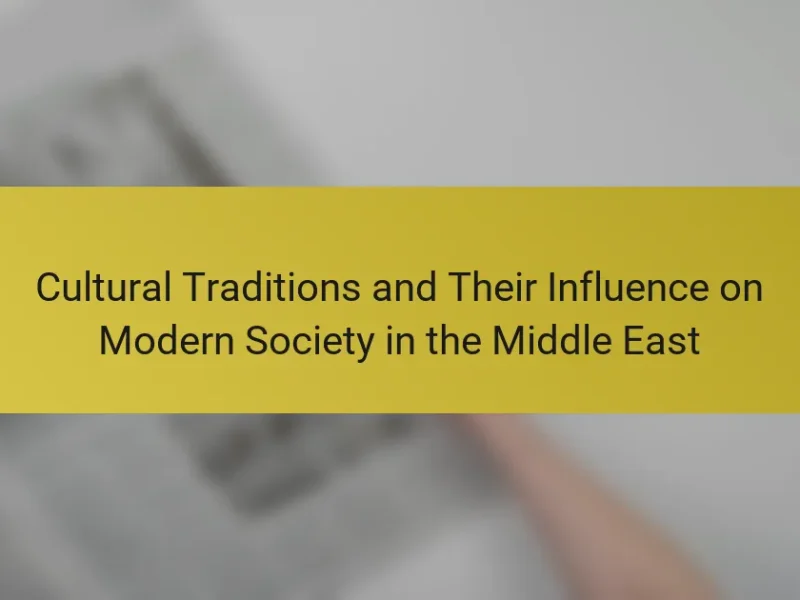
What is Traditional Cuisine and Its Role in Middle Eastern Identity?
Traditional cuisine in the Middle East encompasses a variety of cooking styles, ingredients, and dishes that reflect the region’s diverse cultures. It plays a crucial role in shaping Middle Eastern identity by preserving cultural heritage and fostering community. Traditional dishes, such as hummus, falafel, and kebabs, often feature locally sourced ingredients, showcasing the agricultural practices of the area. Meals are typically communal, emphasizing hospitality and social bonds. Festivals and family gatherings frequently center around traditional foods, reinforcing cultural traditions. The preparation and sharing of these dishes often involve generations of knowledge, highlighting the importance of family and history. The significance of traditional cuisine is recognized in the UNESCO designation of various Middle Eastern food practices as intangible cultural heritage. Thus, traditional cuisine serves not only as sustenance but also as a vital expression of identity and continuity in Middle Eastern societies.
How does traditional cuisine reflect cultural values in the Middle East?
Traditional cuisine in the Middle East reflects cultural values through its ingredients, preparation methods, and communal dining practices. The use of local ingredients showcases the region’s agricultural heritage and connection to the land. For example, staples like wheat, rice, and legumes represent sustenance and resourcefulness. Traditional cooking methods, such as slow cooking and grilling, emphasize patience and respect for food.
Communal dining practices highlight the importance of family and hospitality in Middle Eastern cultures. Sharing meals fosters social bonds and reinforces community ties. Dishes often have symbolic meanings, such as lamb during celebrations, which signify abundance and sacrifice.
Religious influences also shape traditional cuisine, with dietary laws dictating food choices and preparation. For instance, halal practices ensure food is prepared in accordance with Islamic principles. Overall, traditional cuisine serves as a living expression of cultural identity, values, and history in the Middle East.
What are the historical influences on Middle Eastern traditional cuisine?
Middle Eastern traditional cuisine is influenced by various historical factors. Ancient trade routes facilitated the exchange of spices and ingredients. The Silk Road connected the East and West, introducing diverse flavors. Islamic expansion spread culinary practices across regions. Ottoman rule contributed rich dishes and techniques from different cultures. Colonial influences also shaped local cuisines through the introduction of new foods. Each of these factors has left a lasting mark on the region’s culinary identity.
How do family traditions shape culinary practices in the region?
Family traditions significantly shape culinary practices in the region by influencing recipes and cooking methods. These traditions often dictate the use of specific ingredients that are culturally significant. For instance, the use of spices like sumac and za’atar is common in family recipes passed down through generations. Family gatherings often feature traditional dishes, reinforcing cultural identity. Seasonal celebrations also dictate certain foods, such as lamb during Eid, which is a vital part of the culinary landscape. Additionally, stories and rituals associated with food preparation enhance the connection to heritage. This culinary practice fosters community bonds and preserves regional identity. Studies show that these traditions contribute to a sense of belonging and continuity within families and communities.
What are the key components of traditional Middle Eastern cuisine?
Key components of traditional Middle Eastern cuisine include grains, legumes, vegetables, and spices. Grains such as rice and bulgur are staples in many dishes. Legumes like lentils and chickpeas provide protein and fiber. Vegetables such as eggplant, tomatoes, and cucumbers are commonly used. Spices including cumin, coriander, and sumac add flavor and depth. Olive oil is a primary fat used in cooking and dressings. Traditional dishes often feature grilled meats, such as lamb and chicken. Additionally, bread, particularly pita, is a fundamental part of meals. These components reflect the region’s agricultural practices and cultural heritage.
What staple ingredients are commonly used in Middle Eastern dishes?
Common staple ingredients in Middle Eastern dishes include rice, wheat, and legumes. Rice is often used in pilafs and served alongside various meats. Wheat is a primary ingredient in bread, such as pita and lavash. Legumes, including lentils and chickpeas, are frequently used in salads, stews, and dips like hummus. Additionally, herbs and spices such as cumin, coriander, and mint are essential for flavoring. Olive oil is commonly used for cooking and dressing dishes. These ingredients reflect the agricultural practices and cultural traditions of the region.
How do cooking methods vary across different Middle Eastern cultures?
Cooking methods vary significantly across different Middle Eastern cultures. Each culture employs distinct techniques influenced by geography and available resources. For example, Levantine cuisines often use grilling and roasting, particularly for meats like kebabs. In contrast, Persian cuisine frequently incorporates slow-cooking methods, evident in dishes like stews called khoresh. North African cultures, such as Moroccan, are known for tagine cooking, which uses a special pot for simmering ingredients. Additionally, frying is prevalent in Gulf countries, where dishes like samosas are common. These variations reflect local traditions and ingredients, showcasing the diversity within Middle Eastern culinary practices.
What significance does traditional cuisine hold in Middle Eastern identity?
Traditional cuisine is central to Middle Eastern identity. It reflects the region’s rich history and diverse cultures. Dishes often symbolize hospitality and community values. Ingredients and cooking methods vary across countries, showcasing local traditions. For example, the use of spices in dishes like kebabs and pilafs highlights cultural influences. Traditional meals often bring families together, reinforcing social bonds. Festivals and religious observances frequently feature specific foods, linking cuisine to cultural practices. Overall, traditional cuisine serves as a vital expression of heritage in the Middle East.
How does food serve as a medium for cultural expression in the Middle East?
Food serves as a medium for cultural expression in the Middle East by reflecting traditions, values, and social identities. It embodies historical influences from various civilizations, including Persian, Ottoman, and Arab cultures. Traditional dishes often signify communal gatherings and celebrations, reinforcing social bonds. Recipes are typically passed down through generations, preserving cultural heritage. Ingredients used in Middle Eastern cuisine often symbolize regional agricultural practices and local resources. For example, spices like cumin and coriander are integral to the flavor profiles of many dishes. Additionally, food rituals, such as breaking bread together, emphasize hospitality and community. Overall, food in the Middle East is a vital expression of identity and cultural continuity.
In what ways does traditional cuisine foster community and social ties?
Traditional cuisine fosters community and social ties through shared meals and cultural rituals. Eating together strengthens bonds among family and friends. Traditional dishes often carry historical significance, connecting generations. Festivals and communal gatherings feature specific foods that promote togetherness. Recipes are often passed down, creating a sense of identity and belonging. In Middle Eastern cultures, hospitality is a key value, with food serving as a medium for welcoming guests. This practice encourages social interaction and reinforces community ties. Furthermore, traditional cuisine often reflects local agricultural practices, fostering appreciation for regional resources and collective identity.
How does traditional cuisine influence modern Middle Eastern identity?
Traditional cuisine significantly influences modern Middle Eastern identity by preserving cultural heritage and fostering community ties. Dishes like hummus, falafel, and kebabs serve as symbols of regional pride. These foods often reflect the agricultural practices and local ingredients specific to each area. Family gatherings and communal meals centered around traditional dishes strengthen social bonds. Additionally, traditional cuisine is a medium for sharing stories and history across generations. The revival of ancient recipes in contemporary settings showcases a blend of tradition and modernity. Festivals celebrating regional foods further reinforce cultural identity. This culinary heritage is often a source of national pride and unity among diverse ethnic groups within the Middle East.
What are the challenges faced in preserving traditional cuisine today?
Preserving traditional cuisine today faces several challenges. Globalization leads to the homogenization of food cultures. Many traditional dishes are overshadowed by fast food and international cuisine. Urbanization causes a decline in traditional cooking practices. Younger generations often prefer convenience over traditional preparation methods. Economic factors also play a role; traditional ingredients may become scarce or expensive. Additionally, climate change affects agricultural practices and food availability. Cultural shifts can result in the loss of knowledge about traditional recipes and cooking techniques. These challenges threaten the survival of culinary heritage in the Middle East.
How do globalization and modernization impact traditional culinary practices?
Globalization and modernization significantly influence traditional culinary practices. These forces introduce new ingredients and cooking techniques from various cultures. As a result, traditional recipes often adapt to incorporate these elements. For instance, fast food chains have proliferated in many regions, altering local eating habits. The availability of international cuisine has expanded consumer choices, often overshadowing traditional meals. A study by the Food and Agriculture Organization (FAO) highlights that globalization can lead to the homogenization of diets. This shift may threaten the preservation of unique culinary identities. In contrast, modernization can also promote the revival of traditional practices through food tourism and cultural festivals. Such events celebrate local cuisine and encourage younger generations to value their heritage.
What efforts are being made to revive and sustain traditional dishes?
Efforts to revive and sustain traditional dishes include culinary programs and community initiatives. Organizations are promoting local ingredients and traditional cooking methods. Educational workshops are being held to teach younger generations these culinary skills. Social media campaigns are raising awareness about traditional recipes. Governments are supporting cultural festivals that showcase traditional foods. Research studies highlight the importance of traditional dishes in cultural identity. Collaborations between chefs and local farmers are strengthening local food systems. These efforts aim to preserve culinary heritage and foster community pride.
What practical tips can enhance the appreciation of traditional Middle Eastern cuisine?
Explore authentic recipes to understand traditional Middle Eastern cuisine better. Cooking traditional dishes like hummus or kebabs can deepen appreciation. Use fresh ingredients, as they enhance flavor and authenticity. Familiarize yourself with regional spices such as za’atar and sumac. Attend local Middle Eastern food festivals to experience the culture firsthand. Engage with community members or chefs to learn about cooking techniques. Pair dishes with traditional beverages like mint tea or ayran for a complete experience. Understanding the cultural significance of meals can enrich your appreciation.
Traditional cuisine is a central entity in understanding Middle Eastern identity, reflecting the region’s diverse cultures and historical influences. The article explores how traditional dishes, ingredients, and cooking methods are integral to cultural values, community ties, and social bonds. It delves into the significance of family traditions, staple ingredients, and the impact of globalization on culinary practices. Additionally, the piece highlights efforts to preserve and revive traditional cuisine amidst modern challenges, emphasizing its role as a vital expression of heritage and identity in Middle Eastern societies.


